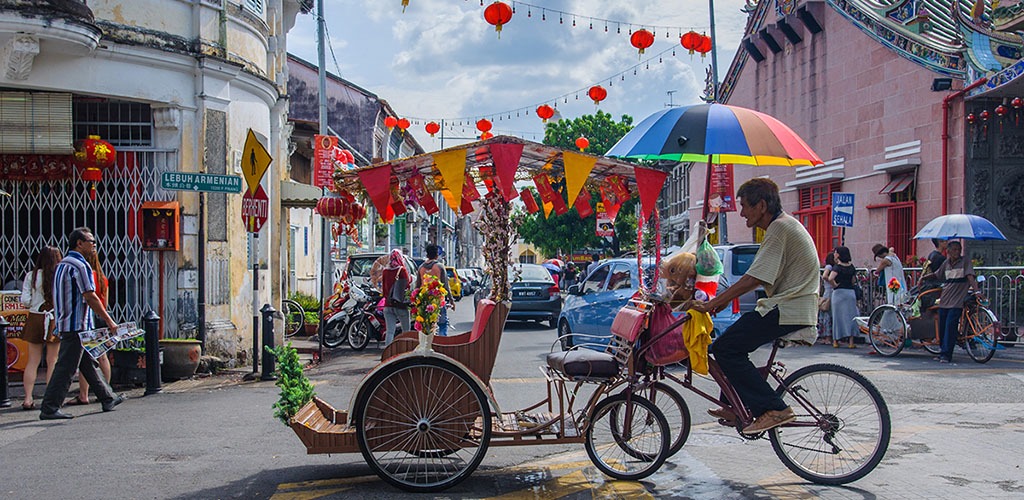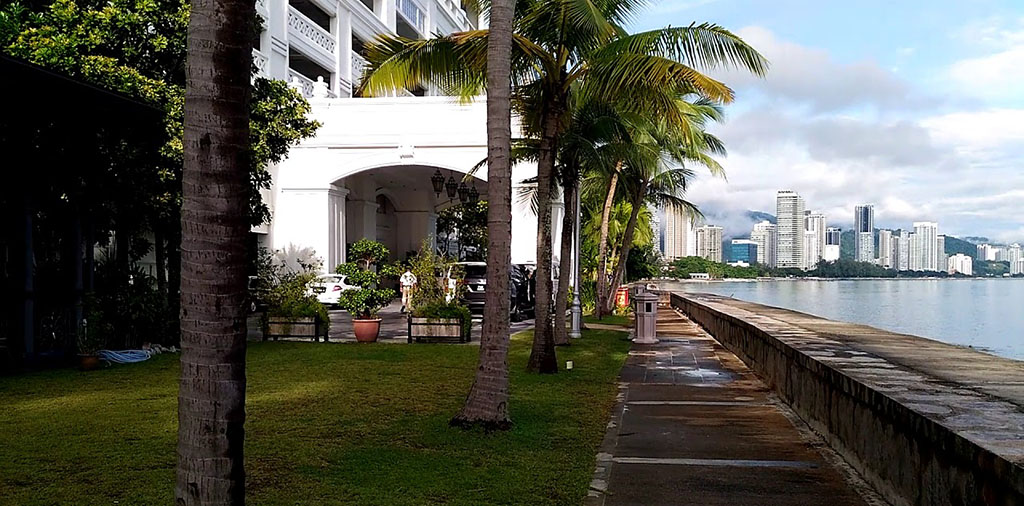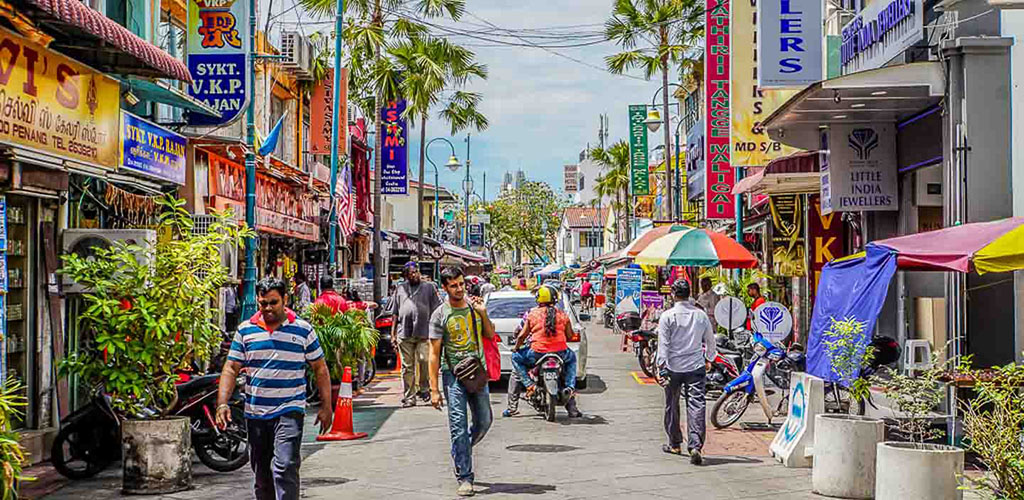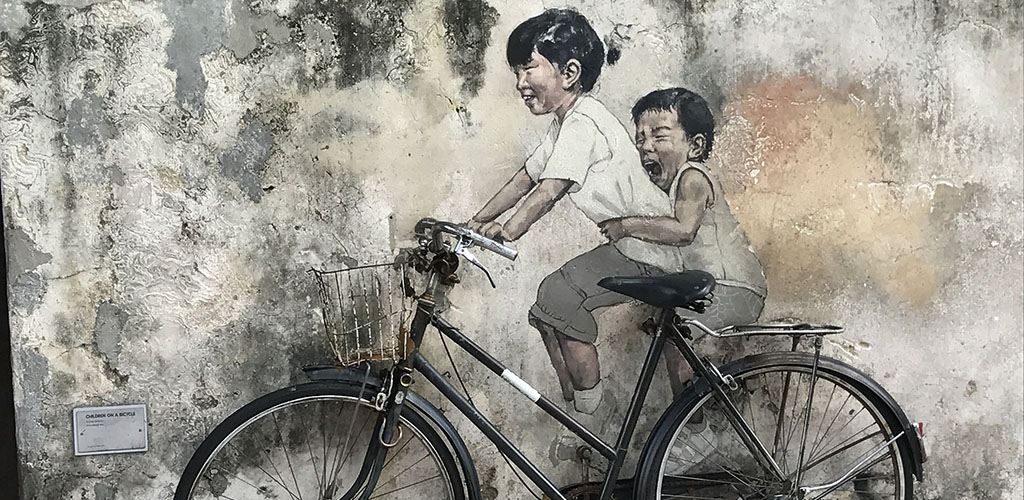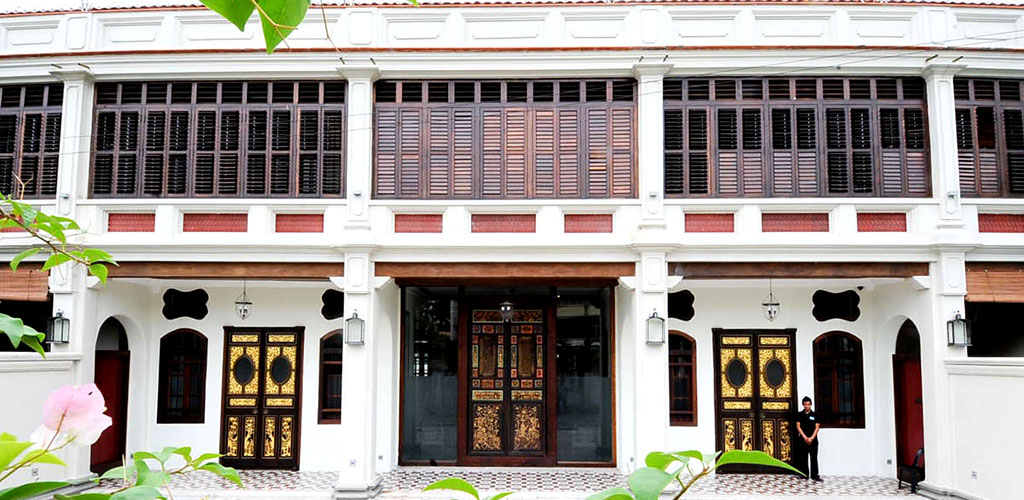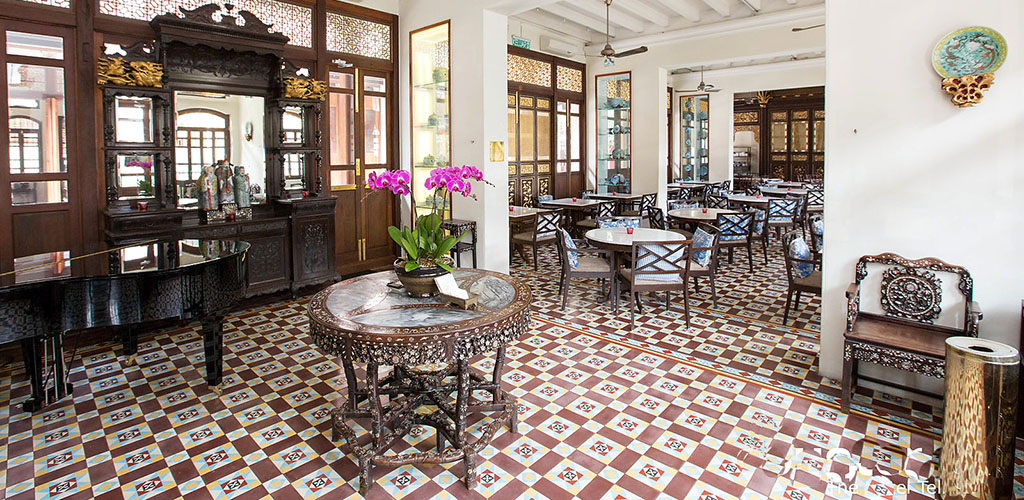Georgetown
Penang is one of our favorite cities in Asia. The sizzle of food in woks, the beat of Bollywood soundtracks and the call to prayer mingle with the scent of spices and a rainbow of colors in the World Heritage-listed historical core of Penang’s capital, glorious Georgetown. And the city is on a roll thanks to an influx of private and public investment and creative energy — precipitated in part by Unesco’s 2008 listing of Penang’s capital city, George Town, as a World Heritage site — the Malaysian island is padding out its list of attractions to the region’s best street food and smart restaurants and bars.

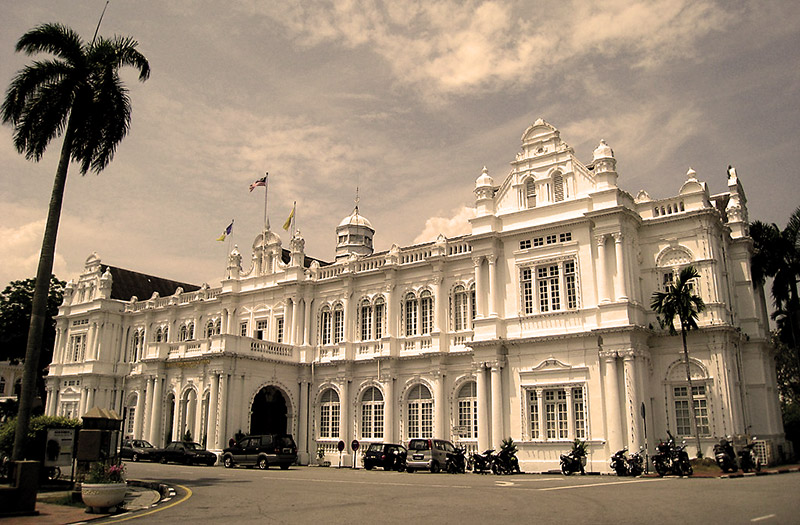
An Economist article titled “Getting back its mojo: After a slump, an early engine of globalisation is thriving again," reported that Penang had emerged as the top choice for investors out of Malaysia’s 13 other states — including Selangor, the most developed — due to its strategic geographic location between Asia’s two rising economic giants with its stickiness for the rule of law as its trump card. A lively street culture anchored in religious festivals has now been joined by shows at the recently opened Performing Arts Center, and events like the Penang World Music Festival, as well as the annual George Town Festival, a month of exhibitions, performances and readings by local and international artists and writers.
Cosmopolitan, chic, and colonial, vibrantly multicultural Penang – a turtle-shaped island off the north-west coast of Peninsular Malaysia – tantalises with its colonial charm, colourful streetscapes and mouth-watering mix of cuisines. Here are fabulous temples, sandy beaches, jungle-covered hills and mingle with an exotic cast of culturally-diverse characters. As the oldest of Malaysia's British Straits settlements, predating Singapore and Melaka, it's no surprise that this established destination has long been on travelers' wish-lists, but a fresh clutch of boutique hotels are bringing a more stylish, intimate flavour to a sojourn here. The island's majority Chinese population help give Penang a personality all its own, but you'll find English and Indian influences afoot in bustling capital Georgetown, too. Sure, skyscrapers, Silicon Valley-esque software smarts and creeping modernity are mixing it with old-fashioned boutiques and bazaars these days, but buzzing from bar to beach in your trishaw – or wandering from tropical national park trails to temple-topped peaks – you can still find a peaceful pocket of the 'Pearl of the Orient' to polish as your own. A stay in Georgetown will also very likely be more comfortable than it would have been a few years ago, with new boutique hotels opening in recently renovated pre-World War II shop houses and mansions.

Getting There

Eastern & Oriental Express
The historic Eastern & Orient Express train runs from Bangkok to Singapore (and ivce versa), passing through lovely landscapes with journaey of two to three nights. From Singapore, Geoergetown and Penang are a short hop away, where we recomend another night or two at the Eastern and Oriental Hotel (not associated with the train), an pleasant base for exploring the island and town.Things To Do & See
200 Years of Multicultural History
Penang was part of the sultanate of Kedah until Captain Francis Light established the British trading post for the East India Company on the island. Light first landed at the site of Fort Cornwallis to take possession of the island in 1786. He supposedly encouraged the local inhabitants to clear the ironwood trees by firing coins out of the cannon into the forested swamp. It was Light who laid the grid of the commercial town, bounded by Light Street (now Lebuh Light), Beach Street (Lebuh Pantai), Pitt Street (Jalan Masjid Kapitan Keling) and Chulia Street (Lebuh Chulia). Beach Street then ran along the beach and Pitt Street was reserved for places of worship.
A handful of military and civilian Europeans settled along Light Street. The Eurasians from Kuala Kedah and Phuket settled along Bishop Street (Lebuh Bishop) and Church Street (Lebuh Gereja). The Straits Chinese traders from Kedah and Malacca settled along China Street (Lebuh China). The various ethnic groups mingled at Market Street (Lebuh Pasar). The early Indian traders, of whom the majority were Tamil Muslims, settled along Chulia Street. By the early 1800s, the town was extended by two more streets - Armenian Street for the Armenians and Acheen Street for the local community comprising Achehnese, other Sumatrans and Malays. Each ethnic group was allotted its own street with a section of the waterfront along Beach Street. However, Penang was established without the formal segregation that characterised the foundation of other colonial towns like Singapore, Hong Kong or Yokohama.
Traders and settlers came from Europe, the Arab world, India and China to the port of Penang. They also came from other parts of the Indonesian archipelago, Thailand and Burma. For most of the first hundred years of Penang's history, the most important items of regional trade were pepper from the Achehnese ports, spices such as clove and nutmeg from the local plantations, and textiles from India. Tin gained importance in the mid-19th century and then rubber. Penang enjoyed great fame as a tourist destination and the former British Straits Settlement was known to have the most delicious food, the poshest residences, the best schools and sporting grounds, and the most pleasant holiday spots in the region
Viewpoint Follow in the footsteps of generations of Penangites to enjoy the cooler climes of Penang Hill. The summit – 821 metres above Georgetown – provides panoramic views across the island and towards the mainland. The recently upgraded funicular railway makes ascending the hill a doddle and once there you can enjoy a pukka high tea or other awfully British tucker at David Brown’s restaurant (www.penanghillco.com.my/index.htm).
Arts and culture
At the heart of Penang’s appeal is its vibrant mix of cultures, with that of the Straits Chinese or Peranakans perhaps the most alluring. Learn all about this hybrid of Chinese and Malay lifestyle at the grand and gilded Pinang Peranakan Mansion at 29 Lebuh Gereja (www.pinangperanakanmansion.com.my). Also not to be missed is the Cheong Fatt Tze Mansion (www.cheongfatttzemansion.com), aka the Blue Mansion, the brilliantly restored late 19th-century home of the ‘Rockefeller of the East’. Located at 14 Lebuh Leith, it's a boutique hotel now, but also offers hour-long guided tours.
Something for nothing
Perpetually swathed in burning incense smoke, 19th-century Kuan Yin Teng Temple on Jalan Masjid Kapitan Keling (Lebuh Pitt) is surrounded by carts selling paper money and other traditional offerings for the Chinese deities. Dedicated to the goddess of mercy, good fortune, peace and fertility, this is one of Georgetown’s busiest temples and is an atmospheric place to linger, particularly when free Chinese opera performances are held in the front courtyard thrice yearly to celebrate the goddess' birthday.
Daytripper
A visit to Penang Hill can easily be combined with Kek Lok Si Temple. A blend of Burmese, Thai and Chinese design, this ‘Temple of Supreme Bliss’ is not only Malaysia’s largest Buddhist place of worship, but also one of its most fantastic – more of a Buddha theme park with its profusion of brightly painted buildings, statues, shops, gardens, fish pools and vegetarian restaurant. Hop in the cable car to reach the foot of the lofty bronze statue of Kuan Yin, goddess of mercy, towering over the complex.
Best beach
Batu Ferringhi’s commercialised strip of beach is a let down and not always clean. Best to continue around the island to the coastal Penang National Park, Malaysia's smallest tucked away in the north-west, where you'll find undisturbed beaches and forest-flanked jungle trails offering the chance to spot wildlife including monkeys and green turtles. Ask the park rangers about the two-hour route to beautiful Pantai Kerachut, a blissful white-sand beach where turtles come to nest.
Perfect picnic
Stock up on baked cookies, bagels and scones at Georgetown's Rainforest Bakery (300 Chulia Street), run by twins Jesse and Jerry Tan, then head to Penang National Park or Penang Hill. The nearby Botanical Gardens (www.penangbotanicgardens.gov.my) on Waterfall Road make a mellow picnic spot, with orchids, ferns, palms and meandering macaques, or try the Tropical Spice Garden (www.tropicalspicegarden.com), just north of Batu Ferringhi, which has a lovely beach just across the road.
Children
Penang’s beaches, jungle, museums and welcoming population make it family-friendly. Kids will love hopping into one of the fake-flower festooned trishaws for a trip around Georgetown’s heritage district. Monkeys and reptiles can be spotted at the Penang National Park, which also has gorgeous beaches and a thrilling canopy walkway hanging 15 metres above the jungle floor. The smalls can also splash in a water theme park on the roof of the Midlands Park Centre mall on Jalan Burmah.
Activities
A half-day cooking class (www.pickles-and-spices.com) includes a shopping trip to the dawn wet market before you get down to grinding spices like a Penang Nonya (Straits Chinese lady). Alternatively, strap on scuba gear for a dive trip with Langkawi Coral just off the uninhabited island of Pulau Payar, 32 nautical miles north of Penang. Or chill out at one of the island’s recent crop of luxurious spas including the Pure Energy Spa.
Colonial Style
In a grassy compound beside the Air Itam river, 6.5-kilometres west of Georgetown, is Suffolk House, a restored Georgian-style mansion on the site of the original residence of Georgetown’s founder Francis Light. Take a guided tour or enjoy high tea.
Georgetown Heritage Walkabout
As anyone know who has traveled Asia, cities you can stroll to all the major sights are few, but Georgetown is one of them. Here is an enjoyable, half-day stroll on what is called the Heritage Trail with your guide taking in the best of the city.
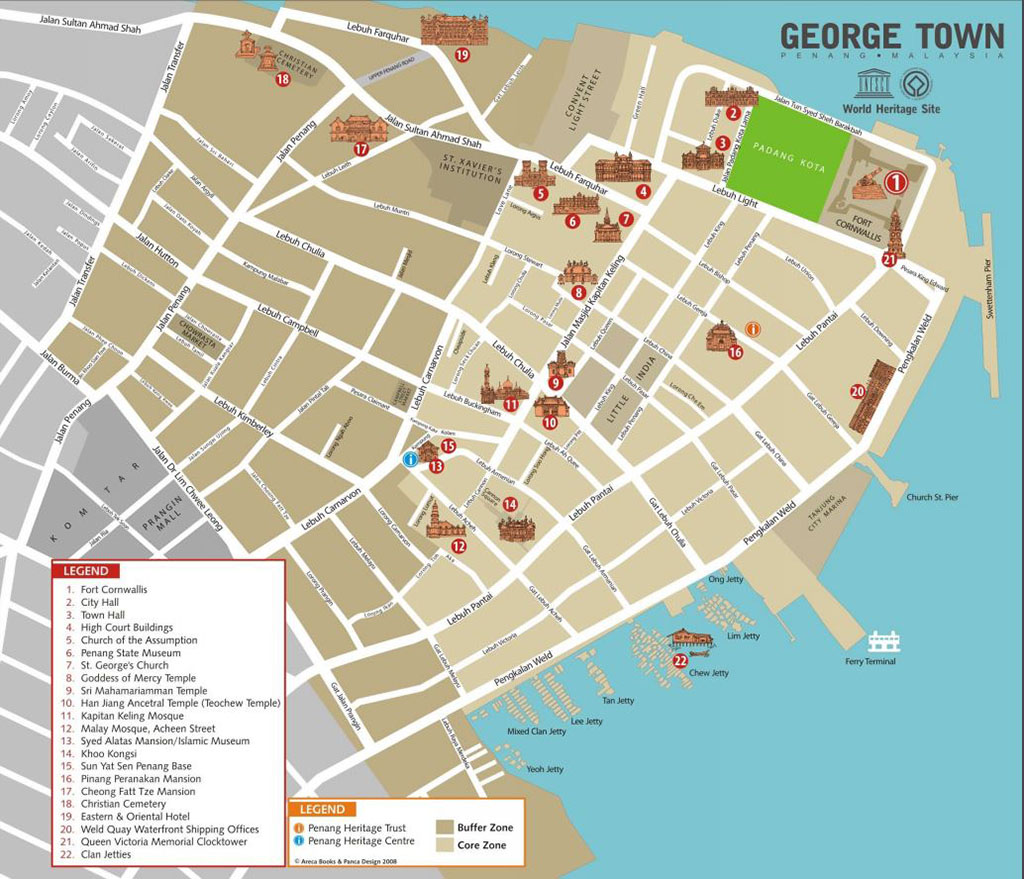
Georgetown Heritage Walking Tour (click to enlarge)
Fort Cornwallis
Welcome to the Penang Heritage Trail Tour. George Town. Today, it is a privately-managed cultural venue which can be visited for a small ramparts overlook the harbaodumr insstihone Nfeoer.thTChehannel and the port activities which extend along the eastern waterfront. At the northwestern point of the fort is a Dutch cannon from 1603, called the Seri Rambai. Local women place flowers on the barrel in supplication for improved fertility. In 2000, the fort was restored and part of the moat was reinstated.
State Assembly Buildings
Along the southern side of the field or Padang, are the State Assembly buildings along Lebuh Light. This handsome ensemble of buildings, with Greek porticos date from the mid-19th century, formerly served as the Police Courts. From the Fort, you can walk along the Esplanade towards the City Hall which is just across the Padang. The Esplanade is popular among locals for evening strolls. At the City Hall end there is a seaside hawker centre.
City Hall
The majestic City Hall (in photograph above) is the jewel in the Municipal Council's crown. The Council Chamber, where the 24 Municipal Councillors regularly convene, is located on the ground floor. The small monument you see on the Esplanade is the Cenotaph, a memorial to victims of World War I.
Town Hall
The Town Hall, like the City Hall, has a balcony that overlooks the Padang. In olden days, the elite used to gather on the balconies of the Municipal Council buildings to view the processions and games held below. The exquisite 19th century fountain next to the Town Hall is one of Penang's many Victorian memorials. Koh Seang Tat, who donated the fountain, lived behind the Town Hall in a grand mansion which once stood at the site of the present Dewan Sri Pinang. He entertained the Duke of Edinburgh in 1869, and thereafter his residence was called Edinburgh House and the road leading to it was named Duke Road. From the fountain, follow the broad grey sidewalk, keeping to the right side of Lebuh Light.
Court Buildings
The Court Buildngs today house the High Courts. Logan's Monument is located in the grounds. The dedication proclaims Logan, who died in 1869, as "an erudite and skillful lawyer, an eminent scientific ethnologist" who has "founded literature for these settlements". Apart from being a fearless advocate, the prolific intellectual was also the editor of the Pinang Gazette and founder of the Journal of the Indian Archipelago and Eastern Asia in 27 volumes, also called Logan's Journals.
Convent Light Street
At the end of the road is the Convent Light St, or Convent of the Holy Infant Jesus, a girls’ school established by a French Sisters' Mission in 1852. Within the walled complex is one of the oldest buildings in George Town, the bungalow of Francis Light which dates back to around 1793. As the seat of the Penang Government in the early 19th century, it was called the "Government House". Stamford Raffles, founder of Singapore, worked here from 1805 to 1810 as Deputy Secretary to the Governor of Penang. The Convent which took over the site then added a chapel, cloisters for the Sisters, an orphanage, a boarding house for student boarders and many classrooms. Today, it is the most important inner city school in Penang and the oldest school complex in the country, having remained on this site for almost one and a half centuries. Follow the wall of the Convent around the corner to Lebuh Farquhar and cross the road at the overhead pedestrian bridge.
State Museum
As you walk around the Court Buildings, you will see a building with twin towers - this is the Cathedral of the Assumption built in 1860. Your next stop is the State Museum, which grants admission for RM1. The Museum only occupies half a building, as the eastern half was destroyed in World War II bombing. The statue of Francis Light which stands in front of the Museum was modelled after a portrait of his son, William Light, founder of Adelaide. The Penang Heritage Trust Museum shop operates from a former Penang Hill Railway Carriage.
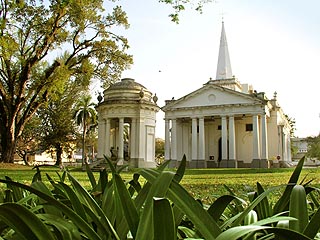
St. George's
The St. George's Church dating from 1818 stands at the corner of Lebuh Farquhar and Jalan Masjid
Kapitan Keling. The edifice was designed by Captain Robert Smith, a military engineer whose oil
paintings of early Penang are displayed in the Museum. This is the oldest Anglican church in the
country, modelled after a large church in Madras. In front of the church is a handsome
memorial to Francis Light, who died on October 21, 1794. The Church maintains much of its
original setting.
Goddess of Mercy Temple
You can walk along the church wall down Jalan Masjid Kapitan Keling, formerly Pitt Street.
This street which is sometimes called the "Street of Harmony" was reserved for the places of
worship important to Penang's multicultural community. Proceeding beyond the church, you will see
a Chinese temple on your right. The Goddess of Mercy Temple was founded around 1800 and
features a sweeping roof with ornately decorated copings and ridges. Today, it is a very
popular temple, visited by young and old alike offering sandalwood incense. Chinese opera or
puppet theatre is performed in the granite-paved forecourt on the Goddess of Mercy's feast days,
which are celebrated three times a year.
Little India
Proceed along Jalan Masjid Kapitan Keling, past the flower-sellers' stalls, and then cross the road toward Lebuh Pasar, formerly Market Street. This is the part of George Town commonly known as Little India, as there are a number of South Indian stores and eating places here. You may want to browse and shop for sarees, garlands, spices, trinkets, sculptures or Indian music.
Mahamariamman Temple
Turn right to Lebuh Queen until you come to the Mahamariamman Temple. This is the oldest Hindu temple in town, dating to 1833, with a magnificently sculptured entrance gate. At the end of Lebuh Queen is the Penang Teochew Association, a 19th century South Chinese district association temple. Note the granite beams and the beautifully gilded paintings of door gods at the facade. From Lebuh Queen, turn right along Lebuh Chulia until you come to the traffic lights, where you should turn left on to Jalan Masjid Kapitan Keling. Here you will find many Indian Muslim money-changers and jewellers. The four-storey landmark at the junction of Lebuh Chulia and Jalan Masjid Kapitan Keling is a Chinese medical hall known as Eu Yan Sang.
Kapitan Keling Mosque
Cross the road to visit the Kapitan Keling Mosque, a monumental mosque crowned by yellow domes.
This is the largest historic mosque in town, founded before 1800. Originally a rectangular
building with verandahs and a hipped roof, the mosque has been enlarged several times.
British architects commissioned by the Muslim and Hindu Endowments Board gave the mosque its
British Moghul Revival appearance in 1916. The elegant minaret dates from this time.
Walk in a counter-clockwise direction around the mosque, past the ablution area, the former
mosque official’s quarters behind the mosque and exit near the old well onto Penang's own
Buckingham Street. Turn left onto Lebuh Buckingham and you will come back to Jalan Masjid Kapitan
Keling. Proceed south to Lebuh Armenian.
Yap Kongsi Temple
As you approach Lebuh Armenian, you will see the Acheen Street Mosque minaret straight ahead in the distance, the Yap Kongsi temple on the right, and on the left, a corner coffeeshop, with the entrance to the Tua Pek Kong Temple next to it. The Tua Pek Kong Temple, dedicated to the Chinese God of Prosperity, was formerly the base of the Straits Chinese secret society called the Tua Pek Kong Society.
Dr Sun Yat Sen’s Penang Base
Follow the graceful curve of Lebuh Armenian. The low and rickety shophouses on your right survive from the early 19th century, when this area was a village composed mainly of Malays and Sumatrans. In the mid-19th century, the Straits Chinese moved into the area and built residential shophouses which were of a fine standard for their time. You will come to a blue shophouse on your right, No. 120 Lebuh Armenian, which dates from the 1870s. The first owner was a Straits Chinese named Cheah Joo Seang, a trustee of the Cheah Kongsi. The shophouse has kept its original historic interior, with carved timber screens and air wells. From 1909-1911, it was the base of Dr. Sun Yat Sen, leader of the historic Chinese Revolution, and the headquarters of the Southeast Asian branch of the Tung Meng Hooi. The local Chinese of that time supported Dr. Sun Yat Sen in the great movement against the Manchu government and the foreign imperialists in China. In 1911, China became the first republic in Asia and Dr. Sun Yat Sen became its first provisional president.
Syed Alatas Mansion
Proceed towards the junction of Lebuh Armenian and Lebuh Acheh. On your left is a children's
playground. On your right is a lovely double- storey bungalow set in a walled compound. This is
the Syed Alatas Mansion, recently restored in a government-funded pilot demonstration project
undertaken with French technical assistance in 1993. Before restoration, the bungalow was
occupied by Indian Chettiar scrap
dealers and was used as a collection yard.
Syed Mohamed Alatas was a wealthy Achehnese merchant of Arab descent who traded between Penang
and Aceh. After the Dutch laid siege on Aceh in the early 1870s, he was instrumental in
smuggling arms to the Achehnese resistance. Syed Mohamed Alatas resided here with his first
wife, a Malay of royal descent. His second wife was the daughter of Khoo Tiang Poh, a leading
Straits Chinese pepper merchant, shipping tycoon and a leader of the Khoo clan.
Lebuh Acheh
From here we turn right onto Lebuh Acheh. In the late 18th and 19th centuries, this was the street of Sumatran and Malay traders. The Arab and Achehnese pepper merchants of North Sumatra, such as Syed Mohamed Alatas, were the leaders of this community. In the old days when the Muslim pilgrimage was more often made by ship rather than by airplane, this street was the centre of Haj activities.
Pilgrims came from North Sumatra, South Thailand and the Northern Peninsula to make their travel arrangements and embark on the Haj. In this area, bustling with travel agencies, shops, restaurants and lodging-houses, the pilgrims mingled, shopped and attended religious gatherings while awaiting the ships that would take them to Mecca. Today, there are still some shops in front of the mosque selling Islamic books and prayer accessories.
Malay Mosque, Acheen Street
The octagonal minaret marks the entrance to the Acheen Street Mosque, founded in 1808 by a wealthy Arab merchant prince from the Acehnese royal family. The mosque is located in the middle of a large compound, surrounded by detached houses which are rare survivors of the mid-19th century village. You can walk clockwise around the mosque, passing the cemetery where the mosque founder, Tengku Syed Hussain, is buried.
Shophouses
George Town’s rich amalgamation of cultural and architectural influences can be seen in no better way than the the shophouses and Chinese clan houses (kongsi). Weave the way through the winding lanes, past cute cafés, art galleries, temples, mosques, shophouses and backpacker lodges to find the fabulously ornate Khoo Kongsi (18 Cannon Square;www.khookongsi.com.my), an outstanding example of a Chinese clanhouse. To learn more about Georgetown's unique shophouse styles as they varied over time from the 1790s to through the 1950, click to view:
Georgetown Shophouse Cross Section
Khoo Kongsi
Coming out of the mosque compound, walk straight ahead onto Lebuh Cannon. This street is supposedly named after a hole in the ground made by cannon balls fired into the area during the Penang Riots of 1867. These were the secret society wars, fought between local groups, which the British tried to suppress. The Straits Chinese from the surrounding clan associations together with the Acheen Street Mosque community formed an alliance against later Chinese immigrants and the Rope Walk Mosque community.
On your left, you will see a row of Straits ecletic-style terrace houses from the late 1930s, faced with Shanghai plaster. On your right are a plainer row of shophouses from the late 19th century. Enter the porte cochere in the middle of the row to visit Penang's most famous historic monument, the Khoo Kongsi at Medan Cannon. You will walk through a charming street flanked by rows of mid-19th century shophouses. Turn right and you will see the recently renovated Khoo Kongsi office building before you come to the majestic Khoo Kongsi, a gloriously ornate late Ch'ng dynasty temple, and the theatre building. Both were recently restored.
The Khoo Kongsi is a clan association of the Leong San Tong (Dragon Mountain Hall) clan, whose forefathers come from Sin Kang clan village in Hokkien province. The Khoos were among the wealthy Straits Chinese traders of 17th century Malacca and early Penang. In the 19th century, the clan complex resembled a miniature clan village, with its own self-government as well as educational, financial, welfare and social organisations. The clan temple was built in 1906 when the Khoo clan was at the height of its wealth and eminence in Penang society.
Cheah Kongsi
Like the Khoo Kongsi and the Acheen Street Mosque, the Cheah Kongsi is located in a large compound accessible only through a narrow entrance. Coming through the gateway, you will find a little surprise - a splendid double- storey Chinese temple with an open balcony and sweeping roof, decorated with British lionheads, standing on the edge of a small but well-kept lawn. Straight ahead is the association's office building, with a charming heritage interior. You can ask for permission to enter the office building and the temple during office hours.
Next steps
Emerging from the Cheah Kongsi, you have several options. We can head back to Fort Cornwallis, we can proceed to the clan jetties at Gat Lebuh Armenian.
Clan Jetties
To make a detour to the clan jetties, we continue east along Lebuh Armenian and Gat Lebuh
Armenian until you reach Weld Quay along the waterfront. Then cross the road and you will
come to the Chew Jetty. This is a clan jetty, a village built on stilts over the sea and populated by members of the same
clan. Altogether there are six clan jetties along Weld Quay. Of these, the Chew Jetty is the
most attractive, with a large community of petty traders, fishermen, stevedores and their
families. Their homes are the attap-roofed timber houses on stilts built over the water, their
streets are the wooden plank walkways and jetties.
![]() View a pdf map with complete description of the George Town heritage walkabout.
View a pdf map with complete description of the George Town heritage walkabout.
Georgetown Arts
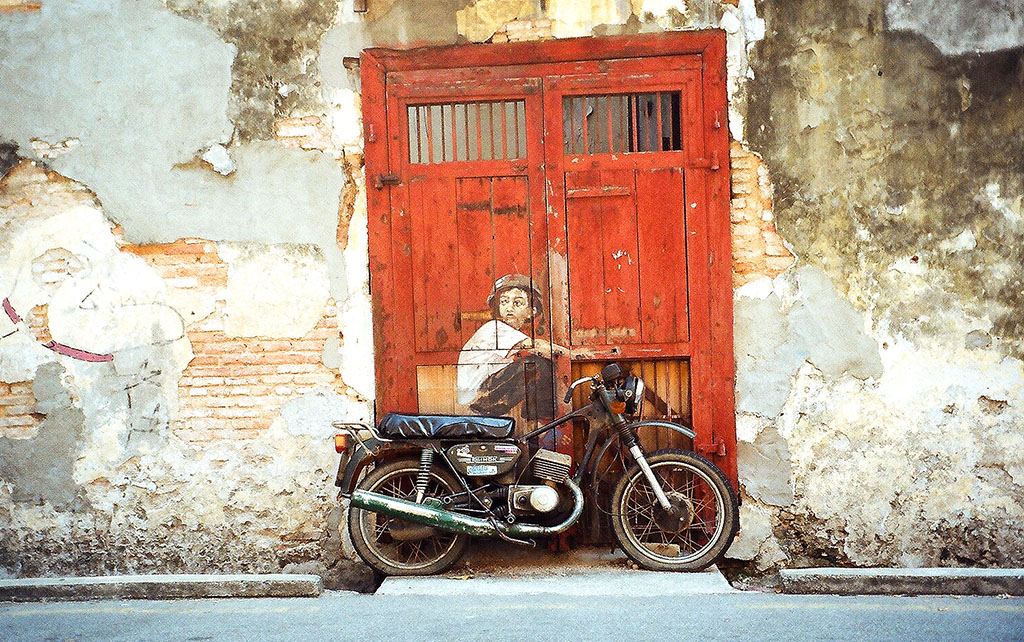
Penang boasts a world-class collection of street art much of it in the style of Banksi, with murals spread around the town. There are also several modern art galleries and spaces, and specialty museums including batik, history, puppeteering and more.
![]() Read A Walking Tour of Penang Street Art
Read A Walking Tour of Penang Street Art

Georgetown Accommodations
Eastern and Oriental ("E&O")
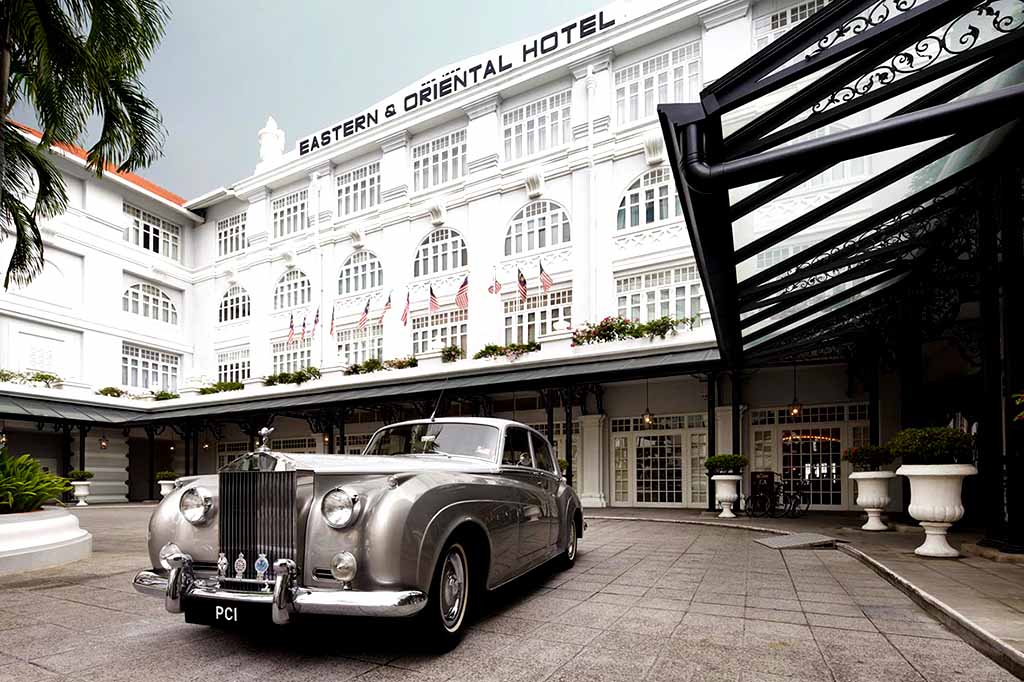
The "Pearl of Penang," the Eastern & Oriental boasts a history that mirrors the city's ride. The E&O is a tranquil haven in the heart of Penang. This is a hotel with old colonial charm and the finest traditions of comfort and service with a reputation and prestige similar to the Raffles in Singapore and the Mandarin Oriental in Bangkok. Right at its door step lies the rich heritage of art and architecture, festivals and food of vibrant Georgetown. The E&O is just a few minutes walk away from a variety of shops, restaurants, cafes, bars and clubs.
With a picturesque location overlooking the ocean, just beyond the city hills, jungle and beaches beckon enticingly. From its foundation by the Sarkies brothers in 1885, the E&O has been patronized by colonial administrators, planters as well as the local and international elite. Among its more famous guests are Noel Coward, Douglas Fairbanks, Hermann Hesse, Rudyard Kipling and Somerset Maugham. Today, it is still the choice for many of the world's most discerning travelers.
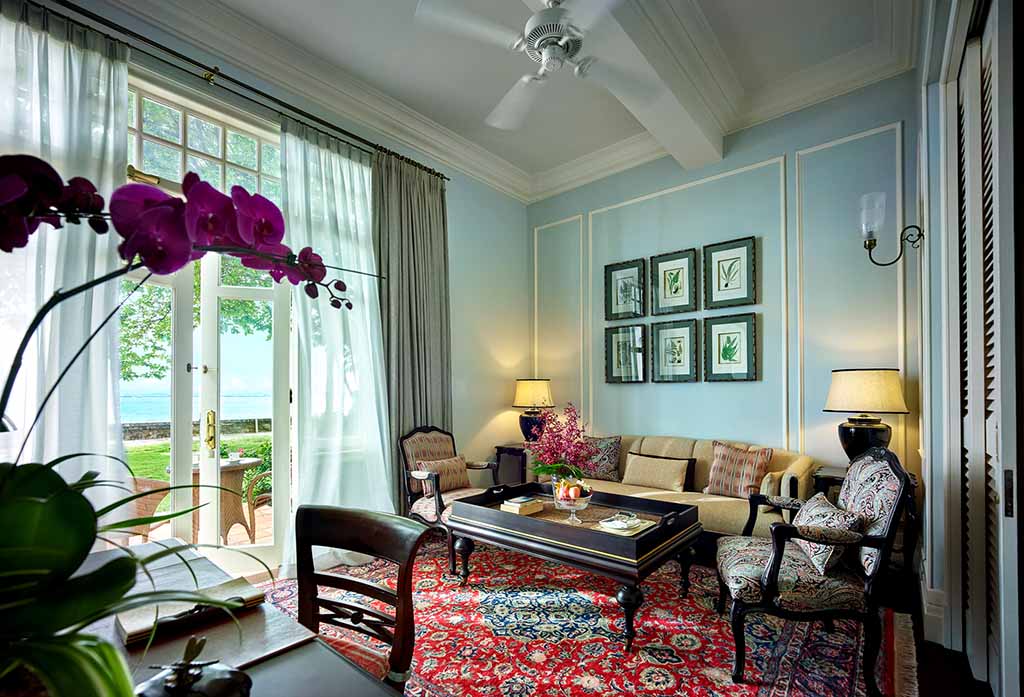
The hotel beautifully showcases its British heritage with its formal daily Afternoon Tea, featuring an array of treats including fresh croissants, macarons, salmon rolls, cucumber sandwiches, fresh scones accompanied by cream and jam, and a diverse selection of traditional and fruity teas. Guests can relish this exquisite experience in the elegant ambiance of the 1885 restaurant. In addition, the neighboring Planter's Lounge offers complimentary Continental breakfast for guests staying in the new wing, the Victory Annexe, which was inaugurated in 2013.

Dining in Georgetown
Cuisine
Prepare for a gastronomic treat: Penang's reputation as Malaysia's food capital is fully justified. Georgetown’s buzzy streets are lined with stalls, cafés and restaurants serving delicious Malay, Chinese, Indian and European dishes, plus the fabulously tasty conflation of Chinese and Malay culinary styles known as Nonya cuisine.
Regional specialties
Must-eats include asam laksa, an iconic dish of rice noodles with a fish-based gravy flavored with sour-sweet tamarind and topped with slivers of ginger flower, chopped pineapple and mint leaves; and laksa lemak – noodles in a light, spicy curry broth. Cleanse your palate with tangy nutmeg juice or a Tiger beer.
China House
You could easily spend a whole day in this sprawling restaurant and gallery complex, which is spread over three heritage buildings on Beach and Victoria streets. Tuck into all-day breakfasts at Kopi C. Espresso, linger over coffee and cake at Beach St. Bakery, lunch on American-style street food and international tapas at Canteen & Bar, knock back a burger at Courtyard Café, or settle in for a fusion feast at BTB & Restaurant.
Matsu
Super-slick, chic decor matches the contemporary Japanese menu at this dinner-only restaurant in Batu Ferringhi's revamped Lone Pine Hotel. Book a day ahead for bento boxes which you can take to the beach for lunch. After, head down to the Batubar for cocktails and a cool crowd.
Nyonya Breeze
If you can’t snag an invite to a Penangite’s home to sample Nonya food, the next best thing is a meal at this unflashy, family-run restaurant; try their kari kapitam (chicken curry with coconut milk and kaffir lime) and otak otak, a spicy fish mousse.
Ocean Green
Ultra-fresh seafood served in a huge dining hall steps away from the beach behind the Paramount Hotel. Try the crab bee hoon (glass noodles) and boiled tiger prawns with chill sauce.
Shing Kheang Aun
The Ah Hok and Ah Hong families have run this simple Hainanese restaurant since 1941. Try their excellent pomfret in a curry sauce flavored with ginger and tamarind, and the fish ball soup with ‘fish float’ (dried and fried fish lungs).
Sri Ananda Bahwan
Superb Indian food is served at this restaurant on the corner; the branch at No 66 is fully vegetarian. It’s a great place to sample the local breakfast of flaky roti canai (unleavened flat bread) with a curry dipping sauce and watch Little India go by.
Tek Sen
When it moved, almost two years ago, from a glorified lean-to in a nearby alley to a spiffed-up shop house, Tek Sen (18-20 Carnarvon Street; 60-12-493-9424; 100 ringgit for two) tripled its seating capacity. That hasn’t diminished the family-owned restaurant’s charm, or its ability to turn out flawlessly executed dishes that have been drawing locals for over 45 years. The extensive menu includes Teochew and Malaysian dishes, each of them memorable. Highlights: stir-fried roast pork with chilies; whole pomfret steamed with ginger, tomatoes, pickled mustard and sour plums; and gulai tumis, stingray in tamarind-soured spicy gravy.
Bars
Edelweiss
Run by Swiss gentleman Urs Capol and his wife Teresa (a wonderful tour guide), this atmospheric café-bar, in a 150-year-old building, offers Paulaner beer to wash down dishes such as cheese fondue and plump German sausages.
That Little Wine Bar - Offering over 50 different quality drops from around the globe, this intimate bar has gathered a loyal following. Chef-owner Tommes turns out tasty food including quiches and desserts
Cafés
Amelie’s Café - An arty, petite café run by artist Hong and partner Yin that’s as charming as the French movie after which it’s named. Serves light meals and refreshing drinks.
Gurney Drive Hawker Centre - North of Georgetown's heritage area beside the sea, this is the most famous – and hence priciest – of Penang’s hawker centers. All kinds of food are available with many competing renditions of the coconut milk-flavoured noodle soup laksa.
Jing-Si Books & Tea - You don’t need to buy into the Taiwanese Buddhist group's teachings to relax over a pot of refreshing tea or coffee in this chic, peaceful café.
Lorong Baru - More commonly known as New Lane, this alley off Jalan Macalister's night-time food stalls can all be relied on for Penang’s classic hawker dishes including charcoal grilled satay. Feeling adventurous? Down a bowl of 'pig spare parts porridge’ at the Chee Chong Chook stall.
Mews Café - Fronting ‘flashpacker’ hotel Muntri Mews (crafted from a row of old carriage houses), this is a sweet spot for a relaxed drink or snack – sample local faves such as nasi lemak and curry laksa or go Aussie with parmesan chicken sarnie and flat white.
Moontree 47 - The trio of local hipsters who run this artsy café, gallery and homestay on Muntri Street have art and design backgrounds, which shows in the playful decor, laid-back vibe and witty address-twisting moniker. They make great coffee and snacks, too.
SiTigun - Round-the-world cyclist Tigun Wibisana settled down in Penang and opened this mellow coffee shop-come bicycle pit stop where the ground bean is taken very seriously.

Shopping in Georgetown
Penang offers a wide range of shopping possibilities. The area in the vicinity of the Heritage Trail is a good place to begin. Most of the antique and curio shops are found along Jalan Penang (near the E & O Hotel), Lebuh Chulia, Jalan Masjid Kapitan Keling and Lebuh Bishop. Along Lebuh Chulia you will find craft shops making timber slats and rattan furniture, as well as budget hotels, Internet cafes, pubs, ethnic clothing and souvenir shops catering for backpacker tourists. Along Campbell Street are traditional Chinese medicine shops, as well as shops selling bags, shoes, leather goods and clothing.
Among George Town’s recent flurry of openings in refurbished structures, China House (153-155 Beach Street and 183b Victoria Street) is the most stunning: over 10,000 square feet of food, drink, and retail and arts outlets in three interconnected shop houses in the city’s warehouse district. The décor leans to heritage chic, with exposed beams, weathered timber and cement floors, an eclectic mix of Chinois, mid-20th century and contemporary furnishings and splashy textiles. Start with dinner at the intimate BTB+Restaurant (dinner for two, 190 ringgit), where the menu runs to Western dishes with Asian and Middle Eastern influences, then climb the stairs to Galleries I and II to view works by Malaysian and international artists. The best place to wind up the evening is at the stylish Canteen+Bar (drinks for two, 80 ringgit), where arty types mingle with (upscale) backpackers and the after-work crowd around a sheet metal-clad bar; local musicians perform on weekends.
Looking for something special? Select specially-mixed perfumes from Badjenid & Sons, at the junction of Lebuh Chulia and Lebuh Pantai. The shop is run by three generations of Yemenite traders. Along Jalan Masjid Kapitan Keling are also Indian Muslim jewelery shops and money-changers.
The old quarter of Penang is famous for its Indian Muslim food and there are lunch spots at Lebuh Union and Lebuh Bishop. There are several hawkers' centers which offer a variety of ethnic foods. There are two which mainly feature Malay food - the hawker center next to Fort Cornwallis caters to the lunch crowd while the one by the Esplanade is most popular in the late afternoon and evening. Along Lebuh Pasar (Market Street) you will find many Indian food stalls especially busy in the morning and at night. Vegetarians can opt for Indian or Chinese vegetarian food. For Chinese food, try some of the coffeshops along Lebuh Union, Jalan Masjid Kapitan Keling, Lebuh Pantai or Lebuh China. 100 Cintra Street and The Garage both have a collection of attractive shops housed in refurbished heritage premises.
Armenian Street is a fabulous little shopping enclave in Georgetown. No 86 Bon Ton The Shop & China Joes (www.straitscollection.com.my) is ideal for stylish souvenirs, including batik-print sarongs, jewelery and objets d’art. On the ground floor at No 88, Fuan Wong (www.fuanwong.com) showcases the fused-glass creations of Wong Keng Fuan; on the second floor Studio Howard (www.studiohoward.com) is a gallery of Howard Tan’s evocative photography of Penang. Nearby Lebuh China is also good for eclectic gallery-boutiques. The Little Penang Street Market (www.littlepenang.com.my) sees Upper Penang Road near the Eastern & Oriental Hotel taken over by craft stalls on the last Saturday of every month. Weekend craft and designer markets are also held at Straits Quay (www.straitsquay.com), a new shopping and entertainment complex beside a marina.

Georgetown & Penang Travel Notes
Packing tips
Penang is a steamy destination, so bring casual cotton and linen clothes. Pack something smart for high-end dining and warm to cope with overly cranked air-con. Comfy walking shoes may sound like boy scout clobber, but they're a must for hiking up Penang Hill; sandals will cut it elsewhere, with flip-flops – or flippers – for the beach.
Recommended reads
The Gift of Rain, by Tan Twan Eng, is set in Penang just before and during WWII, capturing the period's turbulent blend of Chinese culture, British imperialism and Japanese occupation. Island native Tan fondly evokes both the land and its people, offering a nostalgic homage to Georgetown's fast-disappearing heritage. Penang: Through Gilded Doors, by Julie de Bierre and James Bain Smith, is a gorgeously photographed coffee-table book that takes you inside some of the island’s most magnificent homes.
Currency
Malaysian ringgit (MYR or RM).
Time zone
GMT + 8 hours.
Dialing codes
Country code for Malaysia: +60; area code for Penang: (0)4 (ditch the zero if calling from overseas).
When to go.
Penang is a year-round destination with constantly high temperatures (around 20–30°C) and tropical humidity. The rainiest period is May to October, but it’s fun to visit in July when the event-packed Georgetown arts and culture festival is in full swing. Chinese New Year (January or February) is another fab festival time, but it's also a big draw for locals so things can get hectic.
